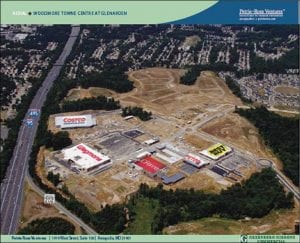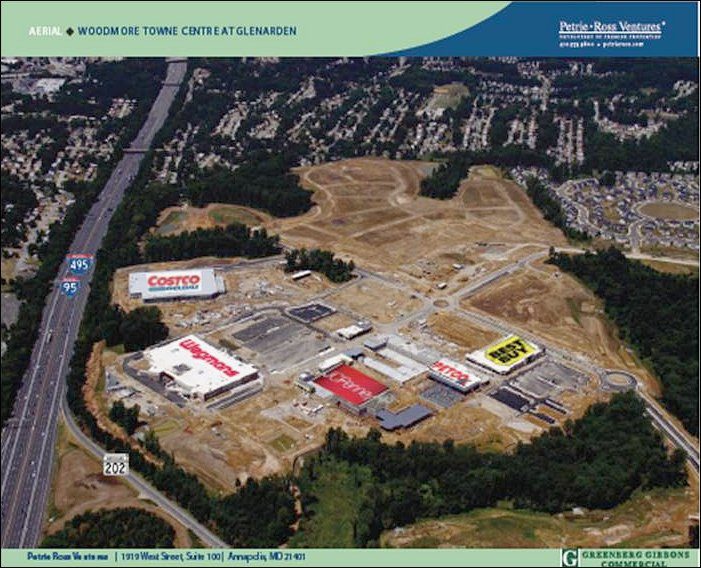
Woodmore Towne Centre in Prince George’s County
It’s been cause for celebration here in the D.C. region, and rightfully so, that suburban Prince George’s County, Maryland, has a new, high-end Wegmans supermarket. It opened last weekend.
“PG County,” as we locals call it, has long been a stepchild among Washington’s suburbs. Those with long memories can recall that this was so even when the county had a majority white population, and so it has remained — and, indeed, worsened in some ways — now that the county has a majority African American population. When middle-class whites fled DC following the 1968 riots in the wake of Martin Luther King, Jr.‘s assassination, those with means fled mainly to Fairfax County in Virginia and Montgomery County, Maryland. But later, as the city’s school system declined and crime increased in the 1970s and 1980s, many middle-class African Americans fled as well: but, in their case, mostly to Prince George’s, east of DC.
Today, PG County is 63 percent African American, and the wealthiest county in America with an African American majority. Its 835,000 residents have a lot of buying power. Some retailers have taken notice, but not all.
Petula Dvorak, describing Wegmans as “the grocery grail,” captured the feeling in The Washington Post:
“Finally, finally, we can say we have something that Montgomery County does not have,” Arthur Turner told me this week. The community activist who has fought for better restaurants and shops in Prince George’s for more than a decade said he’s been beaming, “smiling a Kool-Aid jug smile” all week.
This is a big step toward ending the red-lining of Prince George’s, he said.
“We don’t have a Whole Foods; we don’t have a Trader Joe’s;
we don’t have a Clyde’s restaurant; we don’t have a Sport & Health [a popular local restaurant chain and a popular local gym chain],” he explained.
This has been a point of insult and outrage for one of America’s wealthiest predominantly African American communities.
Whole Foods has a warehouse in Landover. “They store their food here, they make their food here, but they won’t open a store to sell food to the people who live here,” Turner said. “And there is a pent-up need here. People are tired of it.”
So, good for PG residents. It’s about time.
Still, I can’t help but cringe a little that the local measure of suburban success remains big-box sprawl, albeit upscale sprawl in the case of Wegmans. The store will be 130,000 square feet, more than twice the size of the large Giant Foods supermarket in the inner-suburban, upscale Bethesda (Md.) Row development. It’s all on one floor, and plunked amid a sea of surface parking and other one-story, big-box stores (Costco, Best Buy, eventually J.C. Penney; see aerial photo).
The host development is something called Woodmore Towne Centre at Glenarden, “a 245 acre mixed-use development to include retail, residential, hotel and office . . . with more than 1,000 feet of frontage on the Capital Beltway / I-495.” Mixed-use it may eventually be, and I must concede that such is better than 1970s-style malls and strip centers. There are some renderings on the developer’s site that show some pretty multi-story buildings. But in my opinion it is quite unlikely to be confused with true smart growth or a true sustainable community, given its overwhelming automobile dependence and surface parking, along with those relentlessly horizontal retail buildings. Speaking of automobiles, Ralph Uttaro, senior vice president of real estate for Wegmans, told Ovetta Wiggins of The Washington Post that Wegmans customers typically drive from up to 20 miles away to shop there.
My general rule of thumb is that something called “Towne Centre” is likely to be neither, and until proven otherwise that’s unfortunately what I expect of this one. The amount of surface parking in the developer’s site plan is massive.
PG County has great potential for smart, sustainable development, especially around the county’s Metro stations. A platform issued earlier this year jointly by the D.C.-region Coalition for Smarter Growth and Prince George’s Advocates for Community-Based Transit makes the case:
With 15 Metro stations in close proximity to one of the nation’s leading employment centers, Prince George’s County has the best economic development opportunity in the Washington, D.C. region. Strategic economic development [concentrated around Metro and inside the Capital Beltway] can build the strong tax base needed to support quality schools and public safety programs, while increasing the number and quality of employment opportunities available to residents.
The two groups advocate “new urbanist design, green infrastructure, interconnectivity, and pedestrian/bicycle friendliness.” Woodmore may eventually be a baby step in that direction, but only given the configuration of the retail and the vast amount of impervious surface given to automobiles. Not that such is unusual for a Wegmans site, of course.
Subtleties of urban location and design were of no consequence to Wegmans’ opening-day shoppers, 1,500 of whom reportedly formed a pre-dawn line before the store’s 7 a.m. opening on Sunday. Spokeswoman Jo Natale told Wiggins [in a different story; the paper has run at least four stories on the PG County Wegmans] that some were in line as early as 4 am. “It’s a yes we can moment for the county,” said a resident of Upper Marlboro, the county seat.
You know, part of me can’t help but feel good for them. I despise inequities wherever they exist, and this begins to address one. But I also look forward to the day when PG residents are just as eager to get their fair share of walkable, green, transit-oriented neighborhoods as they are now to get their upscale big boxes.
Originally posted on my NRDC blog, where I write (amost) daily about community, development and the environment. The version of this story on my blog archive has several more photos of the new store and its surroundings.





Comments